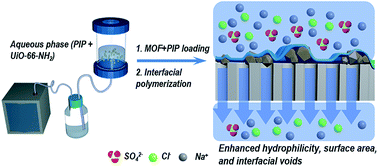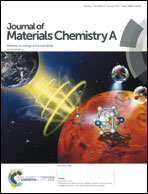MOF-positioned polyamide membranes with a fishnet-like structure for elevated nanofiltration performance†
Abstract
Metal–organic frameworks (MOFs) are increasingly utilized for the design of molecular sieve membranes with unprecedented separation performance, mainly attributed to their nanopore structure and superior polymer affinity. Herein, UiO-66-NH2 crystals were synthesized as functional nanofillers to prepare polyamide (PA) composite membranes. The aqueous solution containing piperazine and evenly dispersed UiO-66-NH2 was transferred onto a membrane surface via vacuum filtration, followed by interfacial polymerization (IP) with trimesoyl chloride (TMC). Covalent bonding between the terminal amine groups of Zr-MOFs and TMC enables the stable immobilization of MOF crystals in the formed PA layer. The positioned MOF nanoaggregates that serve as robust nodes connected by the formed continuous striped film after IP reaction facilitate a rough, fishnet-like surface, which has a larger surface area in comparison to the nodular structure. This unique structure is beneficial for the creation of increased water transport channels, while not compromising the salt rejection. The best performing TFN membranes with a loading mass of 20.5 μg cm−2 exhibited a favorable Na2SO4 rejection of 97.5%, and excellent water permeability (30.8 L m−2 h−1 bar−1). This facile, controlled loading of hydrophilic MOFs via vacuum filtration allows fabrication of crumpled PA membranes with outstanding separation performance.



 Please wait while we load your content...
Please wait while we load your content...